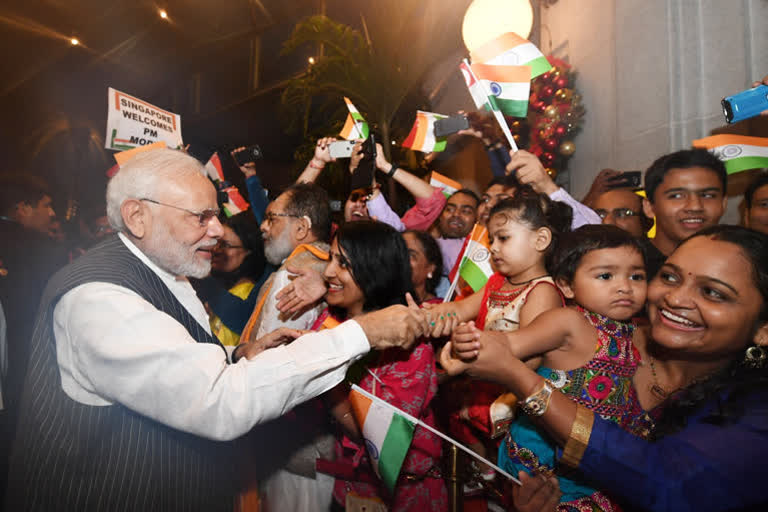New Delhi: Today, the relations between Mother India and her children abroad are on the verge of an unprecedented crisis because of the coronavirus, which threatens the world, particularly the very countries where the people of Indian origin have worked and prospered.
The roles of India as the recipient and the diaspora as the giver are likely to be reversed if the majority of the 30 million people scattered all over the world turn to India for support, instead of giving generously to India. Added to this is the real danger of loss of lives among the diaspora, resulting in cases of deprivation and misery.
Unless the spread of coronavirus is halted and the world economy recovers, India will have a gigantic burden on its hands. With the growth of nationalism in different parts of the world and diminishing international cooperation, India cannot count much on external help.
The United Nations itself remains paralyzed on account of the arrogant approach of China. Even the members of the European Union, which were critical of President’s Trump of extreme nationalism, are themselves turning inward, leaving each country to fend for itself.
The virtual meetings of the South Asian Association for Regional Cooperation (SAARC), G-20 and G-7 produced no concrete plans for jointly fighting the virus.
For a nation, which prides itself as having a diaspora empire on which the sun never sets, the present global pandemic is a reminder of the trials and tribulations of past empires, which crumbled under the weight of their own wealth, glory and responsibilities.
Read:Switch off lights at 9 pm on Apr 5, light lamps: PM Modi urges Indians
The Indian diaspora has been a source of remittances, technology and intellectual power. Ever since the Indian economy was liberalized and began to grow at a rapid pace, the prosperous diaspora in the developed countries and the massive number of migrant workers in the Gulf became the backbone of the Indian economy.
Gulf billionaires struck the British empire back by acquiring iconic institutions like the East India Company and Scotland Yard. The total assets of the 30 million-strong Indian diaspora are estimated to have exceeded India’s GDP and India could bank on their support internationally in political and economic matters.
Looking back at the history of the growth of the diaspora, it will be seen that the various waves of migration out of the country were unorganized and ad hoc.
Individual initiatives in the quest for jobs and prosperity resulted in the migration of various professions in demand in the developed countries from time to time. It was considered a brain drain at one time, but it became a brain gain because India had enough intellectual power to spare. With the opening of the United States for migration, Indian professionals flocked there in spite of the travel restrictions and became immensely prosperous in a relatively short period.
Indian population in the US grew exponentially along with the growth of technology, which became a near-monopoly of Indians. None of these migrations took place as a part of any national plan and the Indian population grew without any statistics being kept on them. Only a fraction of the Indian nationals are registered with the Indian missions.
Read:India to get $1B emergency funding from World Bank to fight COVID-19
The opportunity for workers, particularly semi-skilled and skilled workers which arose in the Gulf region was also unplanned and unexpected. The Indian workforce grew rapidly as a result of individual enterprise, including unscrupulous agents, who exploited them.
But most migrants were able to earn much more in the Gulf than here and there was a continuous flow of workers towards the Gulf and remittances inwards, transforming the Indian economy. Much of the money was wasted on unproductive expenditure like the purchase of property and building of mansions in the absence of any plan for long term investment.
Some of the migrants amassed considerable wealth and white-collar jobs were also created. The Gulf bonanza gradually attracted the attention of the Central and State Governments and a mutually beneficial relationship developed between the Government and the migrants.
Bilateral relations between the Gulf Governments and India developed on account of the reputation of the Indians for hard work and integrity. India responded heartily to the requirements of the diaspora by creating the machinery in our missions abroad and in state capitals and Delhi and instituted the annual Pravasi Divas and Pravasi Samman.
Problems were ironed out as they arose and the mutuality between the Government and the migrants became a saga of mutual respect and cooperation. The intervention of the Government was very helpful in various ways and the richer migrants began investing in India on a massive scale.
Political parties vied with each other to cultivate the leaders of the Indian community, who, in turn, financed them and gained advantages. Whenever the domestic laws demanded the return of Indians, the Government intervened either to retain them there or to give them grants or loans to resettle in India.
In other words, the Indians in the Gulf made their own contribution to the development of India and secured the privileges the state could offer. India went to the support of the diaspora when the latter faced difficulties in different parts of the world.
This was in contrast to the Indian policy in the earlier years of keeping hands off Indians abroad and merely rehabilitating them when they had to leave countries like Burma, the Caribbean countries and Uganda because of their internal laws. The change of policy came at the time of the military coup against the Indians in Fiji when the then Prime Minister Rajiv Gandhi got the military Government expelled from the Commonwealth in 1988.
